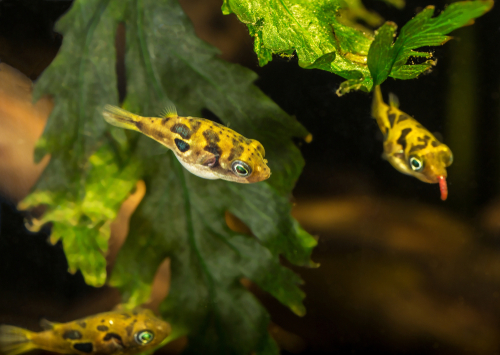Dwarf puffer fish are a popular pick for people that are fleshing out their home aquarium for a couple of different reasons, but especially because of their unique appearance and playful personalities.
Some of the things that make dwarf puffers unique include:
- They are very small fish, with some species reaching a maximum size of only about 1 inch in length. This makes them a popular choice for small aquariums or nano tanks.
- Dwarf puffers have distinctive, elongated bodies and large eyes, which give them a cute and playful appearance.
- They are known for their curious and energetic personalities, and they are often very active and entertaining to watch.
- Dwarf puffers are one of the few species of fish that are able to use their pectoral fins to climb and explore their environment. This makes them very agile and able to explore areas of the tank that other fish may not be able to reach.
Because of their unique personality, though, finding the best dwarf puffer tank mates can be a little bit of an uphill battle.
That’s where this detailed guide comes into play!
Contents
Dwarf Puffer 101 – What You Should Know
Temperament
Dwarf puffer fish are known for their curious and energetic personalities.
A very active and playful fish, they are often very entertaining to watch. Dwarf puffers are also known for their intelligence and problem-solving abilities, and they are known to be skilled at finding and eating live prey, such as snails and worms.
However, dwarf puffers can also be territorial and aggressive towards other fish, especially if they feel threatened or if they are not kept in groups of their own species.
They are best kept in tanks with plenty of hiding places and plenty of room to swim and explore. Overall, dwarf puffers are engaging and entertaining fish that can make a great addition to a well-maintained aquarium.
Size
Dwarf puffers are (unsurprisingly) very small fish, especially when compared to a lot of other species of fish you could keep in your aquarium.
As full grown adults these fish regularly top out around about an inch in length, though from time to time you might get a dwarf puffer that grows even longer than that – but rarely will these fish get longer than 1.5 inches in length.
Yet even though they have a rather diminutive size don’t be shocked if these fish act a little larger than life. They have a huge appetite, are always flitting around their aquarium, and can even act pretty aggressive towards much larger fish if they feel threatened.
This is why it’s such a good idea to have an oversized aquarium when you’re going to keep dwarf puffers and tank mates together.
Competition
Again, even though these fish are so diminutive – they are sometimes called pygmy puffers – they have a reputation for being pretty competitive as soon as food gets added to the tank.
These fish love to eat!
It’s not at all unusual for dwarf puffers to spend a decent amount of time fighting off other fish in their species (and any other fish in the tank, for that matter) as soon as food gets added to their water. Sometimes they are territorial over hiding spots as well.
Generally, these fish get along with everyone else when food isn’t mixed into the equation outside of breeding season. If there are breeding pairs in a tank together, though, things can get cranked all the way up to 11 until the breeding season has concluded.
Tank Setup
These fish – and their ideal tank mates – are going to thrive in tanks with plenty of hiding places and a slow-moving water current. Dwarf puffers are native to slow-moving streams and rivers in Asia, where they hide among vegetation and rocks.
In a tank environment, they need plenty of hiding places to feel secure and to prevent aggression. A tank with live plants, rocks, and other decorations can provide the hiding places that dwarf puffers need. They also prefer a water temperature of around 78-82 degrees Fahrenheit, and they need a water filtration system to keep the water clean and free of debris.
Dwarf puffers prefer water that is slightly acidic to neutral, which is similar to the pH level of their natural habitat in slow-moving streams and rivers in Asia.
These fish are sensitive to changes in pH, and sudden changes can cause stress and illness. It’s important to regularly test the pH level of your tank water and to use a water conditioner to adjust the pH if necessary. A pH level between 6.5 and 7.5 can help ensure that your dwarf puffers stay healthy and thrive in their tank environment.
12 Best Dwarf Puffer Tank Mates
You might also like:
1. Kuhli Loach
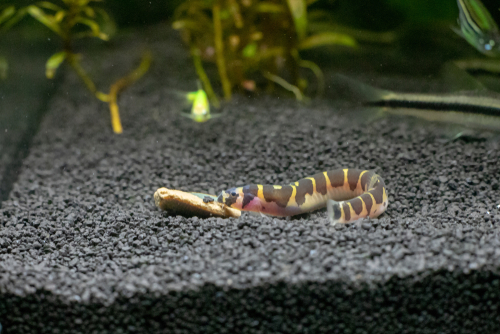
You are generally going to find these kinds of loaches in Southeast Asia, but they’ve quickly become one of the more popular fish to add to an aquarium for a couple of different reasons.
Kuhli loaches have a thin, elongated body with a pattern of dark bands or stripes. They are typically brown or reddish in color, and they have a small, pointed head with small, barbels near the mouth.
Kuhli loaches are peaceful fish and do well in community tanks, but they can be shy and may hide among plants and decorations. They prefer a water temperature of around 75-82 degrees Fahrenheit and a pH level of 6.5-7.5.
The tiny little spikes they have on their body are purely defensive and should discourage your dwarf puffers from getting too aggressive with them.
2. Chili Rasbora
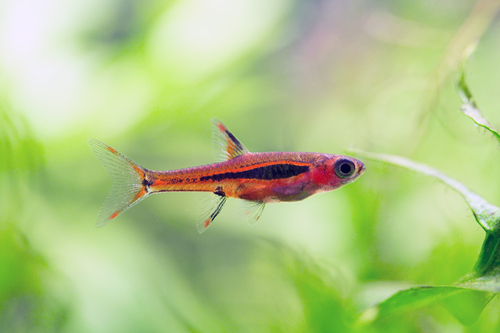
One of the most interesting things about Chili rasboras is their vibrant color. They are small, schooling fish that are native to Southeast Asia, and they are known for their iridescent red or orange coloration.
Chili rasboras are a popular species to keep with dwarf puffers because of their peaceful temperament. They are easy to care for and do well in community tanks with other small, peaceful fish.
Chili rasboras are also a social species and prefer to be kept in groups of at least six individuals. They are a lively and active species that can add color and activity to any tank.
3. Ember Tetra

Ember Tetras almost always do really well with dwarf puffer fish, but you have to be sure that you are keeping them in small schools of between six and 10. If they are kept outside of these schools they are likely to be picked off by the more aggressive dwarf puffers – or at the very least get bullied by those fish when they are feeling rowdy.
As far as the personality of ember tetras are concerned, though, you don’t have much to worry about. They love to swim around the tank but will hide when nervous or anxious – like when dwarf puffers voraciously eat!
4. Otocinclus

Otocinclus catfish are a really fun species of catfish to keep in your tank with dwarf puffer for for a couple of different reasons, not the least of which is to help keep your tank clean and free of algae.
Very social fish (especially as far as catfish are concerned), it’s a good idea to make sure that these fish are kept together with 10 or more other Otocinclus catfish. Even larger schools of between 10 and 20 will really help them thrive in your practically guarantee you never have to worry about algae issues again.
5. Neon Tetra
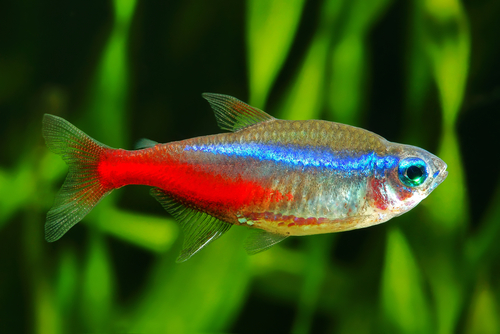
One of the most interesting things about neon tetras is their color-changing ability. They are known for their bright, iridescent blue and red coloration, which is the result of the way light reflects off of their scales. Neon tetras have the ability to change the intensity of their coloration based on their mood, health, and lighting conditions.
For example, when they are excited or stressed, their colors may become more intense. When they are relaxed or in low light, their colors may become duller. This color-changing ability makes neon tetras a fascinating and dynamic species to observe in an aquarium.
You can reliably keep these fish alongside dwarf puffers without any worry!
6. Zebra Danio
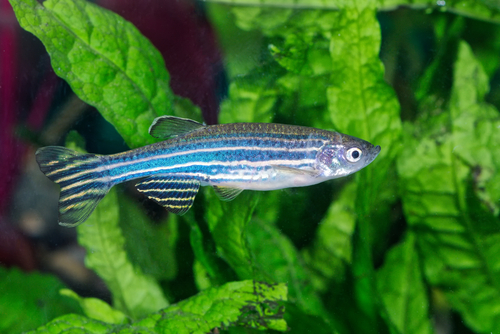
Zebra danios are small, schooling fish that are native to the rivers of India and Pakistan. They are known for their distinctive striped pattern and their hardiness, which makes them a popular species among aquarium hobbyists. Zebra danios are capable of regenerating lost or damaged body parts, including their fins, tail, heart, and even parts of their brain.
This amazing ability is the result of their regenerative stem cells, which can differentiate into various types of tissue and help the fish repair and regenerate damaged tissues. This makes zebra danios a fascinating species to study and observe in an aquarium.
On top of that, these fish will shoal with dwarf puffers, making them excellent tank companions.
7. Clown Killifish
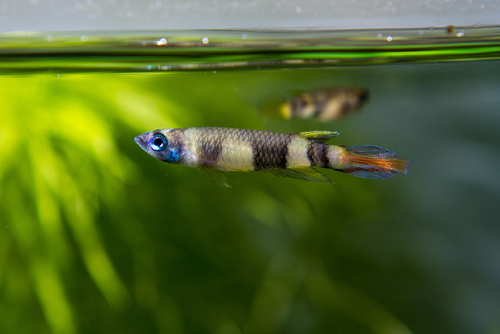
Clown killifish have the ability to change the intensity of their coloration based on their mood, health, and lighting conditions. For example, when they are excited or stressed, their colors may become more intense.
When they are relaxed or in low light, their colors may become duller. This color-changing ability makes clown killifish a fascinating and dynamic species to observe in an aquarium.
These kinds of fish like to be kept together in small schools. They are generally peaceful outside of the mating season when the males of this species can get a little aggressive. Luckily, though, dwarf puffer fish can kind of check that behavior when it bubbles up to avoid issues in the tank.
8. Molly
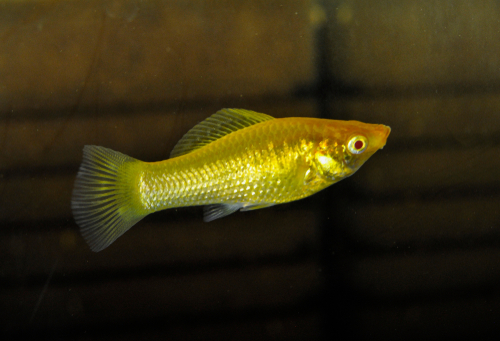
Molly fish are small, hardy fish that are native to fresh and brackish waters in North and Central America. They are popular fish keepers for their peaceful temperament and their ability to thrive in a wide range of water conditions.
Mollies are able to tolerate a wide range of pH levels, temperature fluctuations, and salinity levels, which makes them a versatile and easy-to-care-for species. They are also able to adapt to different types of food, including live, frozen, and flake food, which makes them a good choice for aquarists who want a hardy and adaptable fish.
9. Cherry Barb

Cherry Barbs are incredibly social fish that have a peaceful and relaxed demeanor, though if pressed or pressured by more aggressive fish in your aquarium setting they don’t mind defending themselves, either.
These fish love to live in schools of between six and 10 other fish, and those other fish don’t necessarily have to be Cherry barbs as well. The group up in bigger shoals – including with dwarf puffers – and that makes them exceptional tank mates for sure.
10. Platy
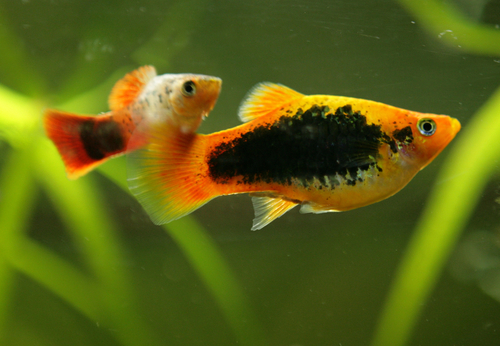
These fish can be a wonderful addition to your dwarf puffer aquarium. Peaceful and friendly, these fish come from Central America which means they are highly adaptable to the same kind of tank conditions that your dwarf puffers enjoy.
One of the really cool things about these fish is that they are life bearing. This means that female platies carry their young until they are ready to live on their own, at which point they are released and then they join the rest of your aquarium community.
11. Dwarf Rainbowfish

Another fish that makes for a great tank made, these fish are just big enough not to beat in by your dwarf puffers but not so large that they are going to threaten other fish, either.
This helps keep balance and peace throughout your aquarium, though you’ll be able to achieve even more peace by making sure that there’s only one male dwarf rainbow for in the tank at a time. You can have a whole bunch of females with that singular mail, but multiple mail dwarf rainbow fish will inevitably fight one another for the favor of these ladies
12. Corydora
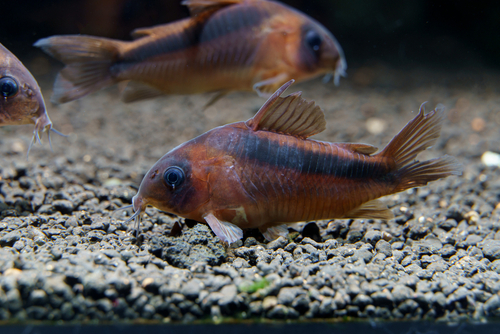
A wonderful species of catfish to keep in your aquarium, corydora catfish (often just called Cory fish) are super peaceful and super timid – even if they look a lot more imposing because of the armor that they wear on their scales.
These fish are going to spend a ton of time in the bottom of your aquarium water column and are highly nocturnal, so they aren’t ever going to bother or frustrate your dwarf puffer fish.
Closing Thoughts
If you’re serious about keeping your dwarf puffer fish happy with their new tank mates there are three things to really focus on:
- Provide plenty of hiding places: Dwarf puffers are territorial and need plenty of hiding places to feel secure. A tank with live plants, rocks, and other decorations can provide the hiding places that dwarf puffers need.
- Keep the water clean and well-filtered: Dwarf puffers are sensitive to dirty and poorly-filtered water, and they need a good filtration system to keep the water clean and free of debris. Regular water changes and gravel cleaning can also help keep the tank clean and healthy for your dwarf puffers.
- Feed them a balanced diet: Dwarf puffers have a voracious appetite and need a varied diet to stay healthy. They should be fed a combination of live and frozen foods, such as bloodworms, brine shrimp, and daphnia. It’s important to avoid overfeeding and to remove any uneaten food from the tank to prevent water pollution.
Take care of those essentials and choose tank mates from the list above and you’ll be all set!

Ian Sterling, founder of Fishlab.com, began his aquarium journey over 30 years ago, driven by a deep fascination for fish and their diverse personalities. His website, Fishlab.com, is dedicated to making fishkeeping accessible and enjoyable, offering beginner-friendly guidance, expert insights, and a community for aquarists to connect and share experiences.


